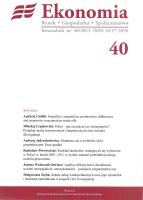Rozkład dochodów wahających się wyborców w Polsce w latach 2001–2011 w świetle założeń probabilistycznego modelu głosowania
Swing voters distribution into the income groups in Poland in the years 2001–2011: Probabilistic voting model perspective
Author(s): Radosław PiwowarskiSubject(s): Economy, Micro-Economics
Published by: Uniwersytet Warszawski - Wydział Nauk Ekonomicznych
Keywords: probabilistic voting model; swing voters; income groups; parliamentary elections in Poland
Summary/Abstract: Probabilistic voting models developed in political economics are often used as a tool for the analysis of electoral processes. The analyzed model assumes that voters have their own ideology and political preferences. They are divided in terms of income into three groups. Politicians fighting in the election are focused primarily on the swing voters. For this reason, proposed election programs are adapted to the most numerous group of swing voters. This is necessary for electoral victory. It is assumed that the largest group of swing voters is among the richest. The purpose of the article is the empirical verification of assumption concerning the number of swing voters in distinguished income groups. To complete the goal data collected under the project Polish General Election Study (PGSW) from parliamentary elections in Poland for the years 2001–2011 is used. By the use of statistical methods the swing voters distribution into the income groups is verified. The analysis shows that in seven out of eight cases the differences in the number of swing voters in the distinguished income groups are not statistically significant. It is therefore concluded that there is no relationship between the income level and hesitation in making final electoral decision.
Journal: Ekonomia. Rynek, Gospodarka, Społeczeństwo
- Issue Year: 2015
- Issue No: 40
- Page Range: 85-107
- Page Count: 23
- Language: Polish

